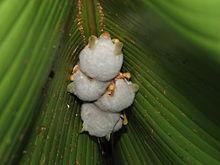Fruit vampires
| Fruit vampires | ||||||||||||
|---|---|---|---|---|---|---|---|---|---|---|---|---|

Artibeus sp. |
||||||||||||
| Systematics | ||||||||||||
|
||||||||||||
| Scientific name | ||||||||||||
| Stenodermatinae | ||||||||||||
| Gervais , 1856 |
The fruit vampires (Stenodermatinae), also known as fruit bats , are a group of bats that are classified as a subfamily of leaf noses (Phyllostomidae). This group includes around 65 species in 18 genera, all of which live on the American continent .
description
Fruit vampires are small to medium-sized bats with a head body length of 35 to 100 millimeters and a weight of 5 to 90 grams. Their fur is usually brown or gray, sometimes white or blackish. Many species are characterized by light stripes on the face or back. The tail is absent in all species, and the uropatagium (the flight membrane between the legs) is small. Most species have a small nasal blade on their face that is used for echolocation .
Way of life
Fruit vampires are native to tropical and subtropical regions of Central and South America. Their habitat is mostly forests or grasslands with trees, but they are absent in overly dry habitats. They are usually nocturnal, unlike many other bat species, many species sleep on trees or bushes, but some prefer hollow tree trunks, caves or man-made dwellings. Some species, including the tented bats , transform large leaves into "tents" that offer them protection from the weather and privacy from predators.
As the name suggests, fruit vampires mainly feed on fruits. Some species also consume nectar , pollen or insects.
Systematics
The fruit vampires are classified as a subfamily of the leaf noses , which includes the "real" vampire bats . In some systematics, the short-tailed leaf noses (Carolliinae) are also counted among the fruit vampires.
There are 18 genera, some of which are monotypical :

- Lesser white-shouldered bat ( Ametrida centurio )
- Tree bat ( Ardops nichollsi )
- Jamaican fig bat ( Ariteus flavescens )
- Actual fruit vampires ( Artibeus ), 18 species
- Old man's face ( Centurio senex )
- Chiroderma , five types
- White bat ( Ectophylla alba )
- Chocolate fruit dwarf ( Enchisthenes hartii )
- MacConnell fruit vampire ( Mesophylla macconnelli )
- Sickle- winged bat ( Phyllops falcatus )
- Striped fruit vampires ( Platyrrhinus ), 14 species
- Ipanema bat ( Pygoderma bilabiatum )
- Umbrella bat ( Sphaeronycteris toxophyllum )
- Red fruit vampire ( Stenoderma rufum )
- Yellow-shouldered bats ( Sturnira ), 13 species
-
Uroderma , 2 types
- Gelbohrer Bat ( Uroderma bilobatum )
- Yellow-bored bats ( Vampyressa ), five species
- Great stripe- faced bat ( Vampyrodes caraccioli )
literature
- Ronald M. Nowak: Walker's Mammals of the World. Johns Hopkins University Press, 1999, ISBN 0801857899 .